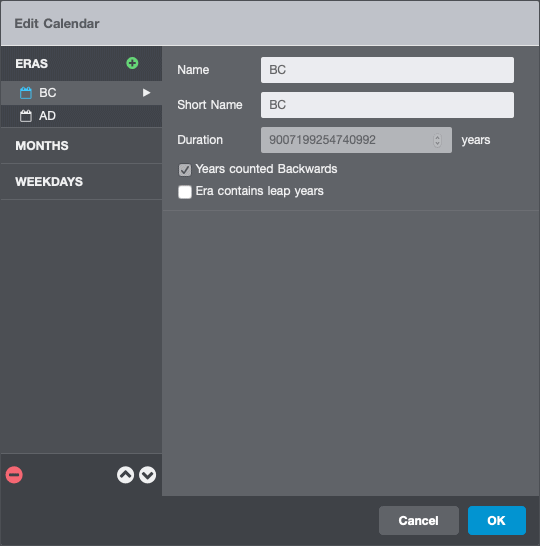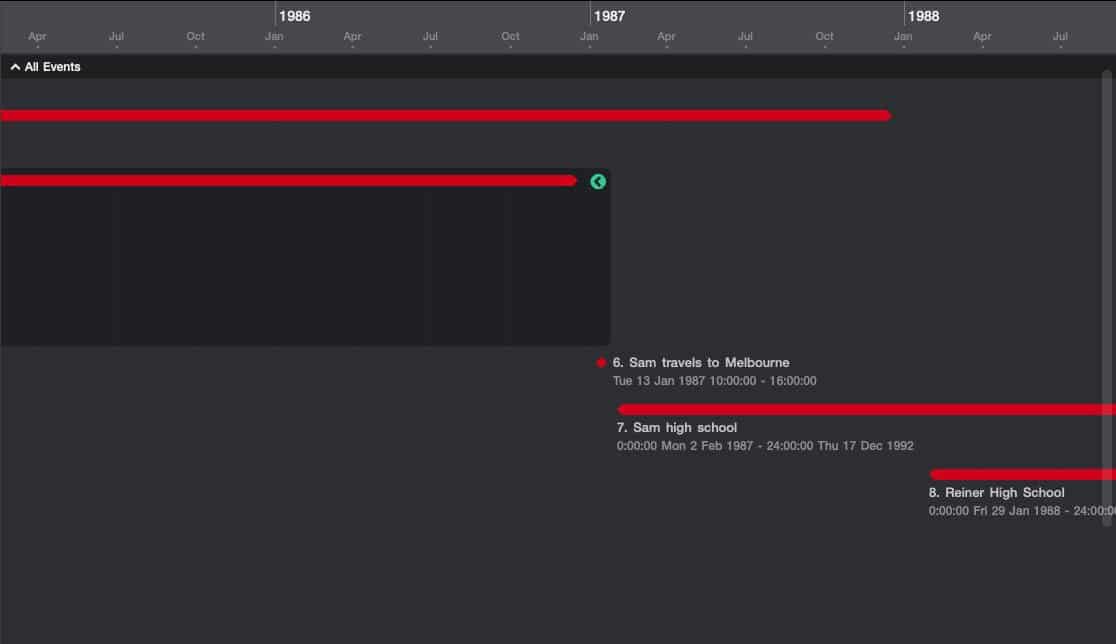Aeon Timeline 2 is a well-oiled piece of software with various uses. Writers might use it in two distinct ways:
- As a project management tool to help get a story completed by a certain date
- As a content creation tool to help get a story onto the page.
I’m interested in the second use. Basically, whatever you put into Aeon Timeline as a storyteller will exist for your eyes only. This is hugely freeing. If you have trouble starting, there’s no ‘blank page’ staring back at you in this piece of software. You’ll very quickly start populating the screen. As you populate the timeline, the story will become more and more concretised inside your head. This, in my view, is the main beauty of Aeon Timeline.
If you’re writing a ‘sprawling’ kind of novel, Aeon Timeline would be indispensable. I’m talking about panoramic novels of the kind pioneered by Dickens: White Teeth by Zadie Smith, The Interestings by Meg Wolitzer or Lonesome Dove by Larry McMurtry.
The Learning Curve
If you love Scrivener, you’re probably the sort of person who’ll love Aeon, too. Scrivener and Aeon sync up. That’s pretty exciting. The main thing to remember here is that Scrivener will make you close the file in Scrivener before working on it in Aeon.
As the Aeon Timeline people say themselves, you really only need to know the basics of this software in order to get started. If you understand Scrivener, Aeon Timeline will be easy to work out. There’s less to it, and works according to similar principles.
What Aeon’s website and user manual won’t tell you: How exactly we might make use of this software to generate content for a story. Every person using Aeon probably uses it differently. (Scrivener is also famous for that.) Below I list some ways I’ve been using Aeon Timeline 2.
This software is really, really useful if you are utilising a homodiegetic character as narrator. Storytellers tend to jump back and forth in a timeline telling their audience each chunk as and when they think of it (actually, as best serves the story). This reads beautifully when done well, but is complicated to pull off. Utilising Aeon’s ‘arc’ entity is helpful when creating a story with a plot full of time leaps and backtracking. The less chronological your plot, the more useful you’ll find Aeon Timeline 2.
I’ll be talking about the Novel template, which I’ve modified as a template. I haven’t needed the others. Aeon Timeline works on both Mac and PC — I happen to be using a Mac.
Do This First
Before you begin writing your story you probably already have an idea about the scale of the timeline. You’ll know whether it takes place over a day, a few months, or over several millennia. To avoid the faff, I recommend limiting your zoom if necessary. It’s set from Days to Hundred Years by default. This zoom works well for most stories but may not for yours.
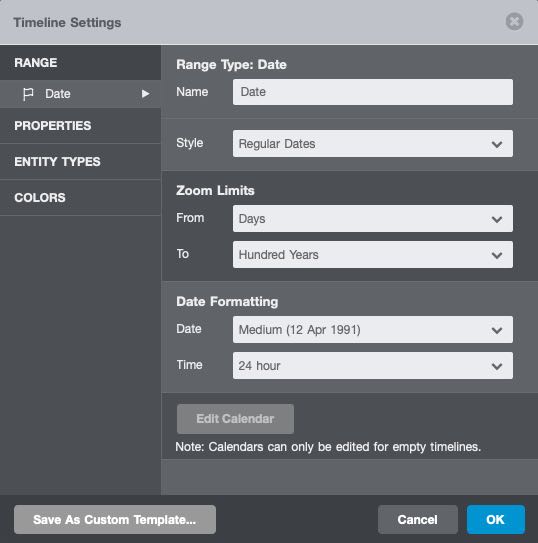
Shortcuts
Generally, shortcuts in Aeon Timeline will work how you expect them to based on your operating system (Command M to minimise on a Mac etc.)
| Control N | Create new event |
| Control R | Add filter (when you’re looking for something) |
| Alt + Drag | Hold Alt while dragging events left or right to alter their end date instead of their start date. |
| Alt+Shift + Drag | While holding down these two keys, draw a line between two events. A pop up will tell you the length of time between the two events. |
THE TWO MAIN BUTTONS
These are the only two buttons you really need to touch as a story creator:
- ADD ENTITY
- ADD EVENT
What is an Entity?
In the dropdown you’ll find three default entities: Character, Arc, Place.
CHARACTER
If you know who your characters are going to be from the outset, go ahead, add them all to your timeline from the get-go, because this is the most efficient way to plan a story. Each time you add an event you’ll be attaching characters to the event. If you know your cast, you can add them all at once by going in to Manage Entities. (Or, you can make them up as you go along and add them at any time.)
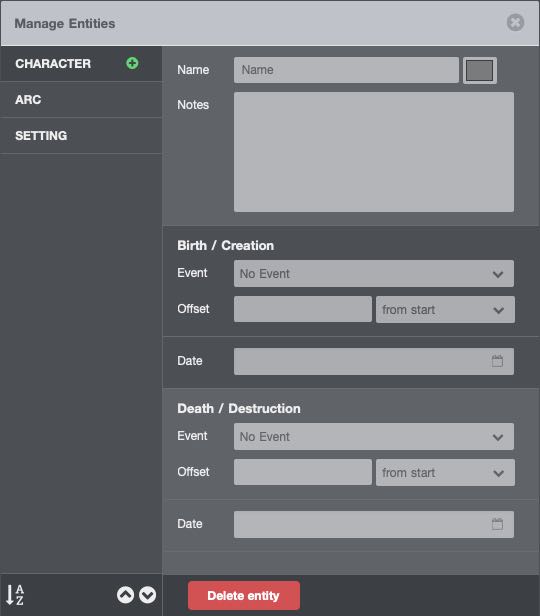
Remember, characters who are not ‘on the page’ can be heavily influential. (Dead mothers, former best friends, former mentors…) Put those characters into your timeline, too.
Definitely add birthdates if you’re writing something which spans years. If you include birthdates in your Character entities, Aeon will do the arithmetic and tell you how old a character is at any given Event. This also means you won’t accidentally forget your character’s birthday. (Birthdays can be useful to plots! Especially in children’s stories.) Besides that, here’s here my own imagination works: Until characters have a birthday and a name, I find it difficult to consider them ‘real’ people inside my head. The simple act of creating these facts fleshes them out in my mind.
I do write long, long character notes — family background, history, details of appearance — much more than will ever appear in the novel. I think this is what lifts a book from that early calculated, artificial stage.
Anne Tyler
By default, Aeon Timeline 2 divides characters by ‘participant’ versus ‘observer’ under character ‘roles’. Decide what that means to you. ‘Participant’ might mean the character was in the scene and spoke, or it might mean they were mentioned. ‘Observer’ might mean the character was there but not mentioned. Or perhaps it means they were there but didn’t speak. Ask how useful is this division really, in your own creativity process?
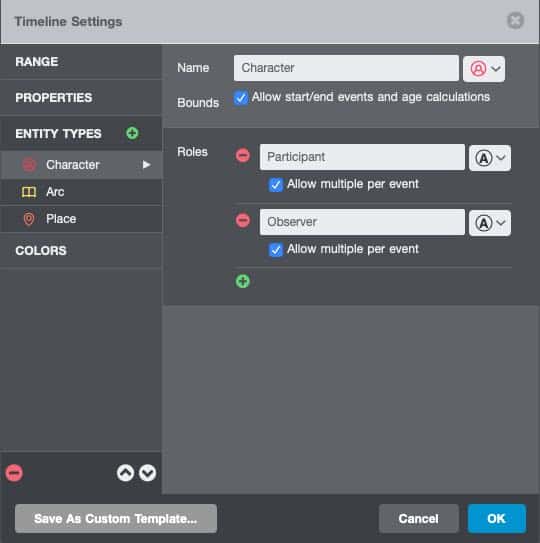
It might be more useful to change those labels to ‘Speaks’ and ‘Doesn’t speak’. This serves double duty as a catch for everyone’s natural tendency to give certain demographics more air time, in fiction as in real life.
We might also add ‘off-the-page but influential’ as an option, as a reminder that just because someone isn’t there ‘on the stage’ they can still drive the narrative a la Voldemort.
ARC
What does Aeon Timeline mean by an arc? That was my first question. Writers tend to use arc in two separate ways: (1) Plot threads and (2) character arcs (to describe how much characters change over the course of the story).
Turns out Aeon Timeline is talking about the plot kind. Note: You can change the names in Timeline Settings to make use of your own favourite terms. Below, I have changed ‘Arc’ to ‘Plot Thread’.
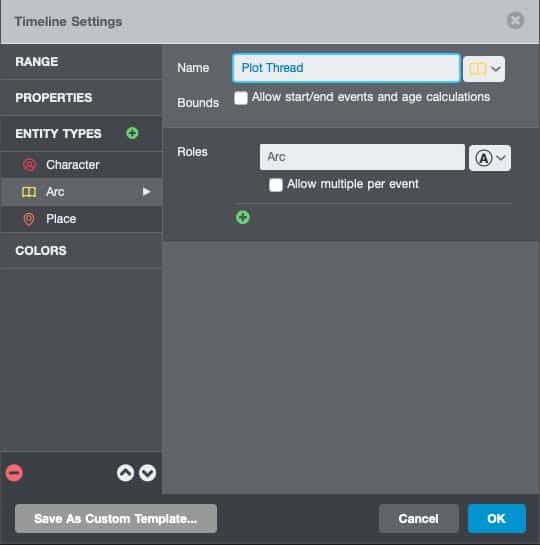
Some people think in terms of plot and subplot, but I don’t buy the concept of a subplot, since every thread needs to have its own complete story structure and how do we decide which is the ‘subordinate’ one? However you think of plots and subplots, Aeon Timeline exists to help us decide which Events need to make it into the final story.
If you’re writing a story about two families, The Smiths and The Joneses, you might create two ‘arcs’: The Smiths… and… The Joneses. This ‘arc’ functionality of Aeon Timeline is really useful if you’re weaving two or more separate threads through your story.
PLACE
Place is self-explanatory but I call it setting. You might have a story that takes place in various places around the world: Wellington, Melbourne and Warwickshire. In Aeon Timeline, create an entity for each setting that occurs within the arena of your setting and attach the relevant ‘place’ to each Event. Usefully, you can attach more than one place to any Event. So, at the outset you may know an Event takes place in Warwickshire, but you haven’t narrowed down which part of Warwickshire. Perhaps you’ll be making up a fictional village. I like to add more than one Place to each Event in a cascading level of detail e.g. Place 1 might be England, Place 2 might be Warwickshire, Place 3 might be Westlake, Warwickshire, Place 4 might be (the fictional) Westland Comprehensive, Place 5 might be Principal’s Office.
There’s more to Setting than ‘Place’, which is why I changed the name. If you’ve ever taught high school literature you’ll have said the following over and over: There’s more to setting than place. As a reminder to yourself, you might manually add the different aspects of setting as you see fit:
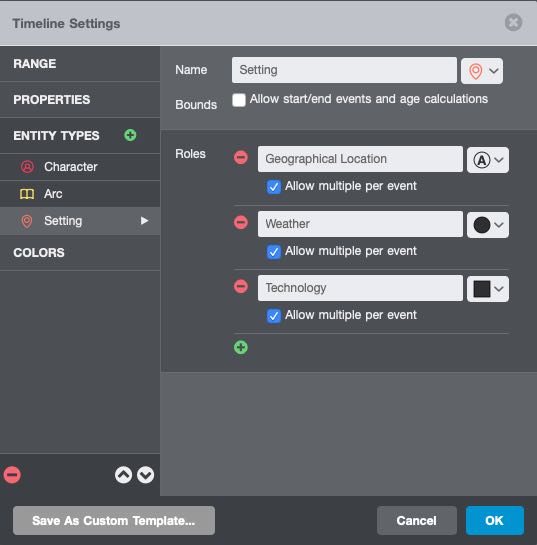
There are even more aspects to setting.
Now, what is an Event?
In writing terms, an Aeon Timeline ‘Event’ is sort of like a scene. Part of me wants ‘Event’ to be renamed ‘Scene’. However, I can see why it’s NOT called a scene. You’re not going to turn every event in your story into a scene. That’s because the Story (the more complete narrative inside your head) is not the same as your eventual Plot (the parts that end up on the page).
Aeon Timeline 2 will let you input all sorts of events which won’t make it into the final story, but which are important nonetheless. Importantly, the Story in your head is always bigger than your final Plot.
Here’s an example of an Event which you probably won’t need for your Story: Your main character’s actual day of birth. (Okay, sometimes modern stories do include the birth of the main character, but most of the time we meet them when they’re older.) Despite that, it’s super helpful to know when your main character was born. For one thing, one of their birthday celebrations might happen in the story.
Birthdays are a funny one in Aeon, because when you create a Character, you’ll be asked if you want to attach their ‘Creation’ to an ‘Event’. If you go ahead and create birth Events you can simply attach it to that. But you don’t need to. You can just type in the character’s date of birth when you create the Character entity. That said, there’s no harm in creating birth Events for your characters even if the story doesn’t really need to know how old they are. Creating birthdates will be necessary for characters who are born on the page e.g. if your main character becomes a parent.
Here’s why Events are a nice concept. A lot of the time, what happens ‘off the page’ is just as important as when happens on it. Adding events to Aeon, even though you may have no intention of turning them into scenes, will help you to flesh out the setting within your own head. Your final product will be all the richer for it. And you might realise before you go ahead and write the scene that the story doesn’t need it. Nothing stopping you writing it for fun, of course. But if you can create a plot timeline in Aeon before writing the scenes, you might save yourself some time.
It’s still really important for you to flesh out a story in your head, as its author. If there are events in your head which never make it onto the page, this will come through to the reader. Your characters will mention things that happened in the past, for instance. Or your third person narrator might summarise some past or future event (by telling not showing) without making a big thing of it. In short, we’re ideally going to be plotting more Events on our Aeon Timelines than crafting complete Scenes in Scrivener.
Aeon Timeline is especially useful to writers who consider themselves at least partly ‘plotters’ rather than ‘pantsers’).
The more obvious use of Aeon Timeline for writers: Consistency. We won’t accidentally put our characters in two places at once, forget their age and birthdays, forget to give them time to travel from point A to point B.
Aeon Timeline As Imaginative Aid
The most important thing I’ve found about writing is that it is primarily an unconscious activity. What do I mean by this? I mean that a novel is larger than your head (or conscious mind). The connections, moods, metaphors, and experiences that you call up while writing will come from a place deep inside you. Sometimes you will wonder who wrote those words. Sometimes you will be swept up by a fevered passion relating a convoluted journey through your protagonist’s ragged heart. These moments are when you have connected to some deep place within you, a place that harbors the zeal that made you want to write to begin with. The way you get to this unconscious place is by writing every day. Or not even writing. Some days you may be rewriting, rereading, or just sitting there scrolling back and forth through the text. This is enough to bring you back into the dream of your story.
Walter Mosley
But there’s another really beautiful use for Aeon Timeline. If we let it, if we don’t let the technicality of it get in the way, Aeon Timeline can help us imaginatively, in the very early stages of plotting. The very first job of the storyteller is to start imagining scenes. If we plot those scenes as ‘events’ on Aeon as we imagine, the timeline will create something solid, clarifying to us which scenes jump out as more important than others. The scenes that we find most interesting will be the scenes to include in the story.
At this early point in the writing process we can then run certain checks before embarking upon writing the first draft.
Aeon Timeline As Pre-writing Checklist
The following must exist in Aeon Timeline (as events) but must by convention be turned into scenes.
- Does the main character change in some way? In which scene does the audience know that they have either changed, or not changed at all? (This change doesn’t have to be for the better.)
- Have you included a scene early on which shows this character’s deficiencies and shortcomings?
- Which scene shows the audience exactly what they want?
- Which scene shows their ghost/fatal flaw?
- Does either the main character or their opponent make some kind of plan? An ‘event’ in your timeline will show the point at which the character makes the plan, but you may choose to hide the specifics from your audience, instead keeping in as a reveal (a la the classic heist movie). If writing a crime story or mystery, you’ll be creating many events in Aeon Timeline which never make it as scenes on the page, summarised as reveals near the end, with clues sprinkled throughout. (You’ll be making use of the audience’s delayed decoding. That’s a fancy way of saying the audience won’t know they were clues until a second read.)
- If you’re writing a love story, is there a scene where one lover shows the audience that these two understand each other?
- Is there a scene where the main character questions themselves, or is interrogated by a friend?
- Is there a scene where the main character is forced to make a moral decision?
- Which scenes comprise the big struggle sequence, where the main character comes close to actual or spiritual death?
- In which of your scenes does the audience realise the character has got what they want (or in a tragedy, has not got what they want)?
- What does the character learn? In which scene does that happen?
- And what does the audience learn about life, the universe and everything? Maybe the audience learns something but the characters don’t (in a tragedy).
Aeon Timeline for Lyrical Works
As you’ve probably gathered, Aeon Timeline is especially useful for certain genres: historical, crime fiction, epic stories which span decades.
Lyrical works are heavily symbolic, and often in these stories temporality itself seems almost beside the point. That said, in order to decipher these stories, you’ll be requiring your audience to read the universal symbolism. The story won’t make sense without it.
While this can be done within Scrivener itself, we might make use of Aeon Timeline to add the symbol thread. This will allow us to see at a glance that it’s introduced early and sustains. If we ‘plot’ symbolism in the same way we ‘plot’ Events, Characters and Places, we’ll naturally give it the thought required. We’ll also be able to cull any accidental imagery which does not serve the symbolism of our particular story.
Fortunately, Aeon Timeline lets us add our own Entities alongside (or instead of) the three provided.
Aeon Timeline For Speculative Fiction
I don’t write sprawling speculative fiction myself, but I can see how easy it would be to set up your own unique calendar system as it applies to, say, a different planet. It’s all done in Timeline Settings. The main thing to remember: You can’t edit how the calendar works at a basic level once you’ve already started adding events to it. In line with common sense, this needs to be set up first. You can do it as you create a new document by going straight into ‘customise’. But if you forget to click the ‘customise’ button, head straight Timeline > Timeline Settings > Edit Calendar.
